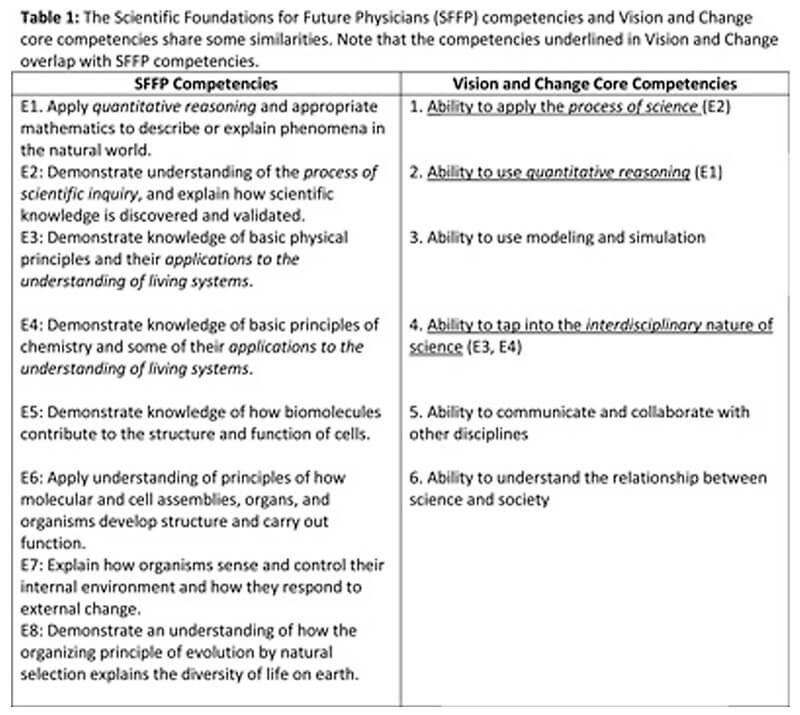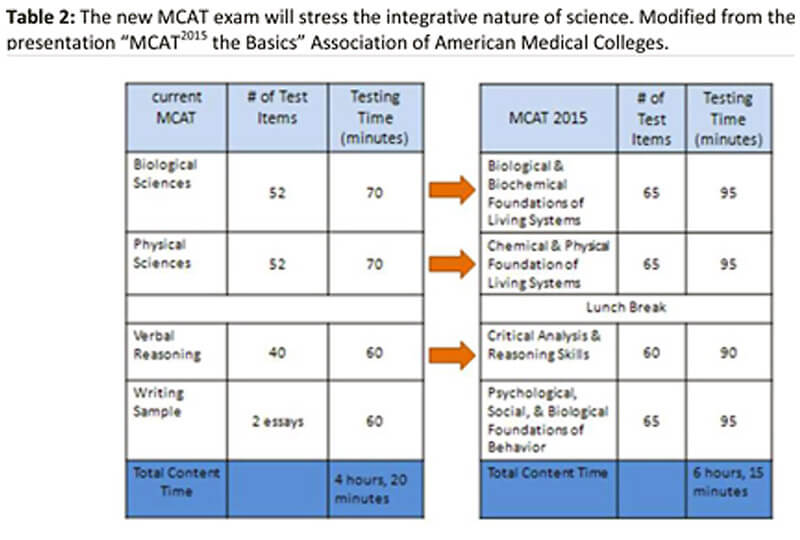The Times They Are a-Changin’: New Expectations in Undergraduate Pre-Medical Education and Medical School Admissions
Published in:
November 16–17, 2012
Dillard University and Xavier University of Louisiana
New Orleans, Louisiana
A concerted movement to improve undergraduate science education began during the first decade of the 21st century. A series of reports have been released which have given the movement momentum. Common themes run through these reports and bring together achievable goals that will help science education better prepare undergraduates for their future careers. Active learning, integration of disciplines, competency-based curricula, problem-based learning, authentic research experiences, and evidence-based teaching are cited in some form across these reports as constructive curricular changes.
National Reports and Initiatives
In 2003, BIO 2010: Transforming Undergraduate Education for Future Research Biologists was published by the National Research Council of the National Academies. This report suggests ways in which the biology curriculum can better reflect the more integrative nature of modern biological research, including the adoption of an interdisciplinary perspective for biology courses and incorporation of active learning.
The American Association of Medical Colleges and Howard Hughes Medical Institute (HHMI) specifically addressed changes to pre-medical and medical education in the Scientific Foundations for Future Physicians (SFFP) report (2009). It presented a shift in emphasis away from teaching stand-alone courses towards achieving eight integrative science competencies. These competencies integrate biological concepts with principles of chemistry, mathematics, and physics (see Table 1). They are drafted in such a way as to allow for flexibility in designing and implementing curricula. In addition to these eight competencies that undergraduates are expected to have upon entering medical school, the SFFP report prescribes eight different competencies that are necessary for medical students to achieve during medical school. The science curriculum at the undergraduate level must provide students with the tools and knowledge they will need to achieve these medical school competencies.
The Vision and Change in Undergraduate Biology Education report (2011) from the American Association for the Advancement of Science reinforces the shift to a competency-based curriculum emphasizing five core concepts for biological literacy and six competencies for all science disciplines. It stresses the need for student-centered learning in which students take responsibility for their education and become active participants instead of passive learners. The Vision and Change competencies outline skills and abilities, whereas the SFFP competencies describe application of knowledge and interdisciplinary understanding of science, though there is overlap between the two (see Table 1).

In 2012, the President’s Council of Advisors on Science and Technology (PCAST) published Engage to Excel: Producing One Million Additional College Graduates with Degrees in Science, Technology, Engineering, and Mathematics. This report proposes a strategy to increase STEM college graduates by 1) improving the first two years of undergraduate STEM education through adoption of evidence-based teaching practices and lab courses with authentic research, and 2) diversifying the pathways to STEM careers.
The NEXUS Project
HHMI is funding the National Experiment in Undergraduate Science Education (NEXUS), which was motivated by the SFFP report, but addresses the issue raised by all the reports mentioned above. It is a collaborative effort among Purdue University, University of Maryland Baltimore County (UMBC), University of Maryland College Park (UMCP), and University of Miami (UM). NEXUS is a pedagogical experiment to create and evaluate new teaching modules for introductory life science education that will incorporate active learning, integration of disciplines, competency-based curricula, problem-based learning, and evidence-based teaching. This integrative curriculum is designed for students to achieve mastery of the eight SFFP competencies (see Table 1) and can be adopted and adapted at any institution. While each partner institution is focusing on one particular aspect of the curriculum, we are achieving validation and dissemination by piloting modules at all partner institutions. When complete, the NEXUS modules will be available through the HHMI website http://www.hhmi.org/grants/office/nexus
The application of interdisciplinary knowledge is the ultimate goal of a competency-based curriculum, which aims to integrate biology, chemistry, and physics while infusing math throughout. This curriculum will provide students with universal problem-solving and critical thinking skills in the life sciences. Competency is achieved by students when they can apply what they know to solving novel problems. But as these NEXUS modules are created and implemented, a challenge remains: how do we best define competency in a practical sense and know when a student has achieved it?
A competency can be defined as what students should know upon completing the curriculum and how their knowledge of science relates to a broader context or understanding. For example, competency E8 for entering medical students is “Demonstrate understanding of how the organizing principles of evolution by natural selection explain the diversity of life on earth.” This is broad to allow for flexibility in instruction; however, specific learning objectives and examples are given under each competency. For E8 the first learning objective is “Explain how genomic variability and mutation contribute to the success of populations.” And a corresponding example is “Explain how inappropriate use of antibiotics has contributed to the evolution of antibiotic-resistant strains of bacteria.”
Students can learn the SFFP competencies through the NEXUS curriculum, which includes:
- Purdue’s chemistry modules focusing on biochemically-relevant material
- UMBC’s mathematical modeling and quantitative reasoning modules for introductory biology and genetics courses
- UMCP’s introductory physics course for biology students
- UM’s case studies which integrate the scientific disciplines through problem-based learning
The NEXUS curriculum will not only teach competencies from an interdisciplinary perspective, but also will assess students’ understanding of science in relation to the big picture and their ability to apply knowledge in order to demonstrate that they are competent. One way in which learner competency is being assessed is through UM’s case study modules. The case studies are different than the other NEXUS modules because they are being used as both teaching and assessment tools. They present students with real life situations or problems through narratives. As they read through the story, they answer questions pertaining to the situation using concepts drawn from biology, chemistry, and physics. The case study modules typically end with an open-ended ethical question to facilitate group discussion in the classroom. The questions require students to use cross-disciplinary knowledge and integrative understanding of scientific concepts.
Drivers of Curriculum Reform
The development of the NEXUS competency-based curriculum is driven by multiple external incentives. First and foremost are the higher expectations for future medical school applicants. The MR5, the fifth comprehensive review of the MCAT, is in the process of revising the medical school admissions exam to better reflect the knowledge and skills now needed to excel in medical school. The MCAT exam has not changed in the last 20 years, even though biomedical knowledge has grown dramatically with the rapid rate of new discoveries and the development of new medical techniques and treatments. The new MCAT, which is due to roll out in the spring of 2015, will be an integrative exam (see Table 2). Whether or not the new MCAT will reflect the SFFP competencies is still an open question; stay tuned until the new exam is released.

Second, as biomedical researchers make new discoveries, treatments are becoming more and more complex. Thus better trained health care providers are needed to be able to administer these treatments and make informed decisions regarding their patients. A third driver is more competition in the professional job market will require students to have a skill set that will make them stand out from competitors.
The NEXUS curriculum will improve career preparation giving life science students a competitive edge in the STEM work force as well as in the applicant pools for professional and graduate schools. Medical school and graduate programs admissions committees are increasingly interested in more than just applicants’ GPA’s and course work. In addition to test scores, admissions committees are looking for evidence of specific qualities and experiences, such as critical thinking, authentic research experiences, ability to apply knowledge, and experience working in a team. The NEXUS curriculum provides all of these skills. Today’s students are entering a highly competitive and increasingly complex society. A competency-based curriculum gives students the skills to make informed decisions as both professionals and citizens of the world.
Science curriculum reform will face many hurdles and educators will need to take calculated risks to create innovative pedagogy. Implementation of a competency-based curriculum may be met with pushback from both faculty and students. Some faculty will need convincing to restructure their courses using a more interdisciplinary approach. NEXUS curriculum components are being validated at the partner institutions. This evidence-based approach will determine whether the curriculum is successful in achieving its intended outcomes. Faculty who may be reluctant to use competency-based modules in their courses will have data to make informed decisions. These data also can be shared with students. Many students, particularly those on the pre-health track, do not want to be forced out of their comfort zone because their focus is on getting high grades to secure their admission to health profession programs. College students today are not willing to put in the extra time required to acquire problem-solving skills. Arum and Roksa (2011) report that today’s college students spend only 12 hours a week studying compared to 25 hours a week in 1961. Our hope is that if NEXUS modules and courses are framed in the right way, with clearly defined goals, explanation for how the goals will be achieved, and most importantly what benefit this brings to the learner, students will become engaged in this new way of learning and be motivated to put in the time and effort required to develop their cognitive skills. Understanding how the competencies relate to their future careers and lives is the ultimate motivator for students.
Science education has come a long way from the days where the professor was a sage on stage espousing her or his knowledge while students listened intently being receptacles rather than discoverers of knowledge. The times are a-changin’. Now students need to be trained as problem solvers with an emphasis on active learning, as opposed to passive learning. They need to understand the integration of sciences, instead of compartmentalizing knowledge into separate disciplines. It is no longer acceptable for teachers to assume their approaches are effective without evidence to validate their pedagogical methods. Although there are many challenges ahead, they will lead to new opportunities for students.
References
American Association for the Advancement of Science (2011). Vision and Change in Undergraduate Biology Education. Retrieved from www.visionandchange.org
Arum, R. and Roksa J. (2011). Academically adrift: Limited learning on college campuses. Chicago: The University of Chicago Press.
Association of American Medical Colleges and the Howard Hughes Medical Institute (2009). Scientific Foundations for Future Physicians.
National Research Council (2003). BIO 2010: Transforming Undergraduate Education for Future Research Biologists. Washington, DC: The National Academies Press.
Spring 2013: New Faces, New Expectations
